If counting sheep has become ineffective for you as a means to fall asleep, there’s an alternative you might consider to help you drift off.
Sleep is a crucial element of maintaining a healthy lifestyle, which explains our constant quest for strategies to either fall asleep more swiftly or enhance the quality of our slumber.
A full night’s sleep remains elusive for many—89 percent of Americans, to be exact. Numerous factors contribute to this challenge, ranging from environmental conditions to individual stress levels.
While some grapple with staying asleep, others find it difficult to fall asleep at all.

This struggle is referred to as sleep latency—the duration it takes for someone to fall asleep after the lights go out. Per the Sleep Foundation, ‘normal sleep latency generally hovers between 10 and 20 minutes’.
To help achieve this optimal sleep latency, TikTok user Dr. Joe Whittington suggested trying the ‘Infinity Tracing Technique’.
In one of his videos on social media, Dr. Joe explained: “Brain won’t shut up at night? Do you ever lay in bed at night overthinking all of the embarrassing things you’ve done since childhood? Same.”
“I’m going to teach you a technique that might help you calm your overactive brain… Try this weird but effective trick to calm racing thoughts and actually fall asleep.”
This method involves raising your finger in the air and slowly tracing the infinity symbol.
“As you’re tracing this infinity symbol, you’re going to just follow it with your eyes—only your eyes,” Dr. Joe elaborated. “What this does is activate your vestibular center which is involved with your balance and eye movements.”
The activation of this center is intended to soothe your thoughts. He likened the technique to distracting a ‘toddler with a shiny object’.
Several viewers in the comments section of Dr. Joe’s video have noted similarities between this technique and EMDR (Eye Movement Desensitization and Reprocessing) therapy.
This type of mental health treatment, according to the Cleveland Clinic, ‘treats mental health conditions that happen because of memories from traumatic events in your past’.
The website further notes that it is commonly employed to treat post-traumatic stress disorder (PTSD).

